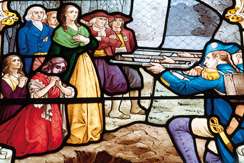Louis Marie Turreau
Louis Marie Turreau (4 July 1756, Évreux, Eure – 10 December 1816, Conches), also known as Turreau de Garambouville or Turreau de Linières, was a French general officer of the French Revolutionary Wars. He was most notable as the organisor of the colonnes infernales during the war in the Vendée, which massacred tens of thousands of Vendéens and ravaged the countryside. He attained army command, but without notable military accomplishments. Under the First French Empire, he pursued a career as a high functionary, becoming ambassador to the United States then a baron d'Empire.
Louis Marie Turreau | |
|---|---|
.jpg) | |
| Nickname(s) | Turreau de Garambouville Turreau de Linières |
| Born | 4 July 1756 Évreux |
| Died | 10 December 1816 (aged 60) Conches |
| Allegiance | |
| Service/ | Army |
| Years of service | 1789–1814 |
| Rank | Général de division |
| Commands held | Armée des Pyrénées orientales Armée de l'Ouest |
| Battles/wars | French Revolutionary Wars War in the Vendée |
| Awards | Knight of Saint-Louis, name inscribed on the arc de triomphe |
| Other work | Governor of Belle-Île Ambassador to the United States Baron d'Empire |
Life
Early life
Louis-Marie Turreau's father was fiscal procurator for waters and forests to the comté d'Évreux, before becoming mayor of Évreux. This situation imparted certain privileges to the Turreau family, even though they were not nobles. Turreau was nevertheless a fervent revolutionary from 1789, profiting like many others, especially the bourgeois of that era. Elected mayor of Aviron, he bought several clerical estates (such as that of the abbaye de Conches).
Career to 1794
Before the Revolution, he had not had any real military activity, having entered the guards corps of the comte d’Artois but only been inscribed for supernumerary roles (he was only a reservist). On the Revolution, he entered the National Guard of Conches, and took over as its leader in July 1792. In September he was elected captain of a company of volunteers from Eure and set out to fight on the northern frontiers. Made a colonel in November, he was integrated into the armée de Moselle.
In June 1793, Turreau was brought into the armée des côtes de La Rochelle, remaining so until 8 October though the post did not please him. He wrote to a friend, "I would move heaven and earth not to go to Poitou. This kind of war displeases me." Even so, he fought for two months in the Vendée. He served as head of the Army of the Eastern Pyrenees from 12 October until 27 November 1793. During that period, he was defeated by Spanish General Antonio Ricardos at the Battle of the Tech (Pla-del-Rey) on 13–15 October.[1] In January 1794, he denounced fellow general Eustache Charles d'Aoust to the Committee of Public Safety, leading to d'Aoust's execution in July.[2] He became commander in chief of the Armée de l'Ouest from 29 December, but he again regarded this post with little enthusiasm. Before he arrived at his post, the last elements of the Armée catholique et royale were erased by Jean-Baptiste Kléber and François Séverin Marceau at the Battle of Savenay on 23 December.
The colonnes infernales

Later career
On 20 May Turreau was named governor of Belle-Île, then arrested on 28 September 1794. He spent a year in prison, which he used to edit his Mémoires pour servir à l’histoire de la Vendée. He refused the amnesty of 4 Brumaire year IV which closed the works of the National Convention, aiming to be unequivocally rehabilitated. On 19 December 1795 he was acquitted by a military tribunal which judged he had only been obeying orders. Under the French Consulate he was sent as an envoy to Switzerland. In May and June 1800, he commanded a division in a diversionary attack on Turin from the west but missed the Battle of Marengo.[3] From 1803 to 1811 he was French ambassador to the United States of America, then commander of several military strongholds.
In 1814, he submitted to Louis XVIII and during the Hundred Days published a Mémoire contre le retour éphémère des hommes à privilèges. On the Bourbon Restoration he was not prosecuted, either for libel or for the colonnes infernales. He was on the list of those awarded the cross of Saint-Louis, but died before being able to attend an official ceremony of the order to receive it.
Distinctions
- Baron de Linières (1812)
- Chevalier de Saint-Louis (1814)
- His name is engraved on the 15th column of the Arc de Triomphe colonne (the Arch shows TURREAU).
Footnotes
- Prats, Turreau
- Prats, Banyuls
- Arnold, p 118 and 130
Sources
Books
- Arnold, James R. Marengo & Hohenlinden. Barnsley, South Yorkshire, UK: Pen & Sword, 2005. ISBN 1-84415-279-0